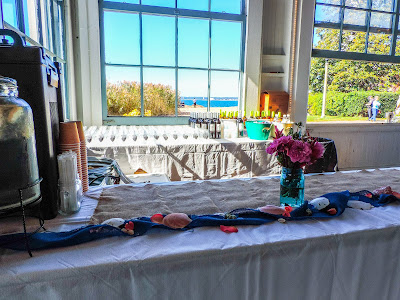We've
made good progress in the past year having our voices heard on the food and
farming issues we care about: healthy food for everyone, support for beginning
farmers, GMO labeling, food justice, fair wages for workers throughout the food
system, excess nutrient pollution and climate change. We have also made
progress in animal care issues. Some restaurant and food chains are planning to
eliminate routine use of antibiotics for animals and gestation crates for
sows. Sellers of unhealthy foods and
beverages are struggling; organic farmers have trouble keeping up with
demand. As consumers and activists, we
are feeling our power to change the paradigm. And, of course, this is all
good. However, the news of the climate,
environmental and/or social chaos in so many parts of the world shows that we
are very far from the path to achieving a livable future for our children and
grandchildren.
Taking
a longer view can keep us focused on what is important. A paradigm is a model
or a way of thinking. Unless we respect and use a cyclical, biological
paradigm, as opposed to a linear industrial paradigm, we don't have a chance
for a sustainable and fulfilling future.
For
many years, the image above has provided me with a useful tool for explaining
the kind of problems caused by and changes needed in the currently dominant,
industrial paradigm.
The Industrial Paradigm
The
industrial model is especially damaging in combination with an economic system
focused on continual growth. There are
often distant and tenuous connections between the human and physical inputs
needed to create a product or service, the consumer or user, and the land, water
and air where the products and pollutants ultimately end up. Because of this,
the external costs of this system, (the tax, environmental and human costs of
production, transportation and disposal), are hidden from consumers. This
results in lots of environmental and human health damage that the consumer
doesn't see or directly pay for.
A
biological paradigm, in contrast, provides essential connections between the
inputs and outputs. This model provides greater transparency and encourages
more localization and cycling of resources. This is good for communities but
not so good for global corporations.
We can
begin to understand the differences between these two paradigms using an
agricultural example: how we get
nitrogen out of the air and into the soil to nourish plants. All nitrogen comes from the atmosphere which
is nearly 80 percent nitrogen. Nitrogen
in the air can be converted (or fixed) into a form plants can use by either
industrial or biological systems.
In the
current industrial model, developed intensively over the past two hundred
years, nitrogen-bearing substances come from far away: in the 19th century from
mineral deposits in Peru and Chile.
Since the early 20th century, nitrogen fertilizer has been produced
through the Haber-Bosch industrial process that now begins with fracking the
earth for natural gas which is then used to make hydrogen. That hydrogen is combined (under great
pressure and high temperature) with atmospheric nitrogen to make ammonia. Then
that material is converted to another form, packaged and shipped to its point
of use on a farm, garden or lawn. From there, some of the nitrogen is taken up
by plants but much of it is moved by water either into the ground, where it
makes well water dangerous to drink, or into streams, rivers and eventually
into estuaries. Higher nitrogen content
makes it much more difficult to process river water for drinking. (See Des
Moines' water supply problems.) It also encourages eutrophication of estuaries
by encouraging the growth of algae.
In
contrast, a biological approach involves using cover crops (e.g. clover, hairy
vetch, alfalfa and field peas) to capture nitrogen from the air with the help
of bacteria living on their roots. Other more local sources of
biologically-fixed nitrogen include rotating leguminous crops (such as peas and
beans) through the growing area, rotating animals through crop land and
applying compost from local manures and other organic wastes. All of these methods can provide the
necessary nitrogen, especially if harsh and toxic chemicals and most tillage are
avoided.
NOFA
Much of
NOFA's work since its founding has been informed by the development and
understanding of the benefits of the biological paradigm developed over the
past century.
In
1971, a group of organic agriculture and healthy food pioneers came together in
Vermont to start the Natural Organic Farmers Association. That organization is now the Northeast
Organic Farming Association (NOFA) with chapters in seven states and almost
6,000 members, including farmers, gardeners, homesteaders, landscapers,
scientists and educators.
The
autumn of 1971 was a time of domestic turmoil over race, the Vietnam War and
the environment. However, these (mostly
young) people were concerned with two things: how to grow food without toxic
chemicals and with getting healthy food to those who needed it. One of NOFA's
first projects was trucking organic vegetables from New England farms to day
care centers, women's shelters and food coops in New York City. (Note 1). A year or so later, the focus
changed to more local markets as the need for good food was discovered closer
to home.
This
occurred less than a decade after Rachel Carson's Silent Spring
documented the damages that pesticides were doing to human and environmental
health. At that time, unless you were connected with the chemical or the
agricultural establishment, it was natural to be concerned about spreading
toxic pesticides on our food. Hence the
interest in organic farming. It is very instructive to read the Wikipedia entry
for Silent Spring. The dynamics
of environmental issues haven't changed much. Corporations which profit from
the industrial paradigm by polluting the environment and damaging human health
use bought science, scientism and shady, despicable tactics to discredit the
honest messenger. They also use their ill-gotten gains to buy cooperation from
their friends in government. Cigarettes, pesticides, GMOs, flame retardants,
fossil fuels, hedge funds, lead in paint and fuel, chlorofluorocarbons (CFCs),
confined animal feeding operations (CAFOs) and synthetic fertilizers are just
some of the areas where this pattern has played out since Silent Spring.
Aside
from the turbulent times and the environmental issues, many of these
enthusiastic young people who founded NOFA were inspired by books from earlier
in the 20th Century including:
1. Soil Scientist FH King's Farmers of Forty
Centuries (1911) which describes his visits to Korea, China and Japan in
1909 to learn how those countries managed to feed themselves for over 4,000
years from small land areas. (Spoiler alert: Intensive cultivation, multi
cropping, cover cropping, composting all organic wastes and human labor were
the keys to their success.)
2. Sir
Albert Howard's An Agricultural Testament (1940) describes his work in
India beginning in 1905. He was sent
there to teach farmers proper British agriculture (fertilizers, pesticides and
the whole industrial approach). Instead, he learned from the Indian farmers
about making and using compost. From observing the health of villagers and
their soils, he learned that "the health of soil, plant, animal and man is
one and indivisible."
3.
Louis Bromfield's Pleasant Valley (1945) and Malabar Farm (1948)
describe what happens to the dust bowl ruined Ohio farms he bought in 1930s as
a result of using cover crops, compost (inspired by Sir Albert Howard)
rotational grazing and sustainable forestry. Springs that had dried up started
running again as soil health improved and natural water cycles functioned
again.
4.
Edward S. Hyams' Soil and Civilization (1952) connected the dots between
the way a society cared for its soil and its long term success or failure.
The Biological Paradigm
The
early 1970s were full of reasons to move toward the biological paradigm. The
first Earth Day was held in 1970. In 1971, Barry Commoner's The Closing
Circle, Nature, Man and Technology was published. It increased interest in ecology and inspired
many of us with Commoner's Four Rules of Ecology:
1.
Everything is connected to everything else. There is one ecosphere for all
living organisms and what affects one, affects all.
2.
Everything must go somewhere. There is no "waste" in nature and there
is no "away."
3.
Nature knows best. Humankind has fashioned technology to improve upon nature,
but such change in a natural system is, says Commoner, "likely to be
detrimental to that system."
4.
There is no such thing as a free lunch. Exploitation of nature will inevitably
involve the conversion of resources from useful to useless forms.
In
1972, we first saw a photograph of the whole earth from space. So, it was hard to be content with a linear
industrial paradigm after that.
Fast Forward
Now
well into the 21st century, with the new challenges from climate change, we can
see the advantages of using the biological paradigm. It turns out that organic methods of soil and
fertility management are among the best strategies for both mitigating and
adapting to climate change. Careful
organic practices can return carbon to the soil while also resisting the
increased droughts and downpours a changing climate brings. Industrial nitrogen fertilizer not only
releases nitrous oxide (a very powerful
greenhouse gas) when it is applied, it also encourages the decomposition of
organic matter, impoverishing the soil ecosystem and driving further climate
change.
Keeping
these different paradigms in mind should help us create a more just,
sustainable and resilient food system. They will help us see the differences,
for example, between systems which consume electricity to provide light and run
pumps indoors to grow leafy greens and those that use sunlight, soil and
compost to grow food nearly everywhere.
In the new year, we need to continue
to use our buying power as well as our actions (i.e., gardening, cooking,
supporting farmers markets, joining CSAs, talking to legislators) to effect the
changes we want to see in the future.
Note 1.
Organic certification didn't exist at that time but organic growing methods
were based on the books listed in this essay and the publications of J I
Rodale. Rodale was inspired by Sir
Albert Howard's writings to start an experimental organic farm in 1940 and Organic
Farming and Gardening magazine in 1942.
His How to Grow Vegetables and Fruits by the Organic Method was
published in 1961 and provided important guidance to early organic
growers. Organic certification began in
the 1980s with NOFA chapters and other organizations developing state
standards. CT NOFA certified farms from
1989 until the USDA took control of "organic" in 2002.












